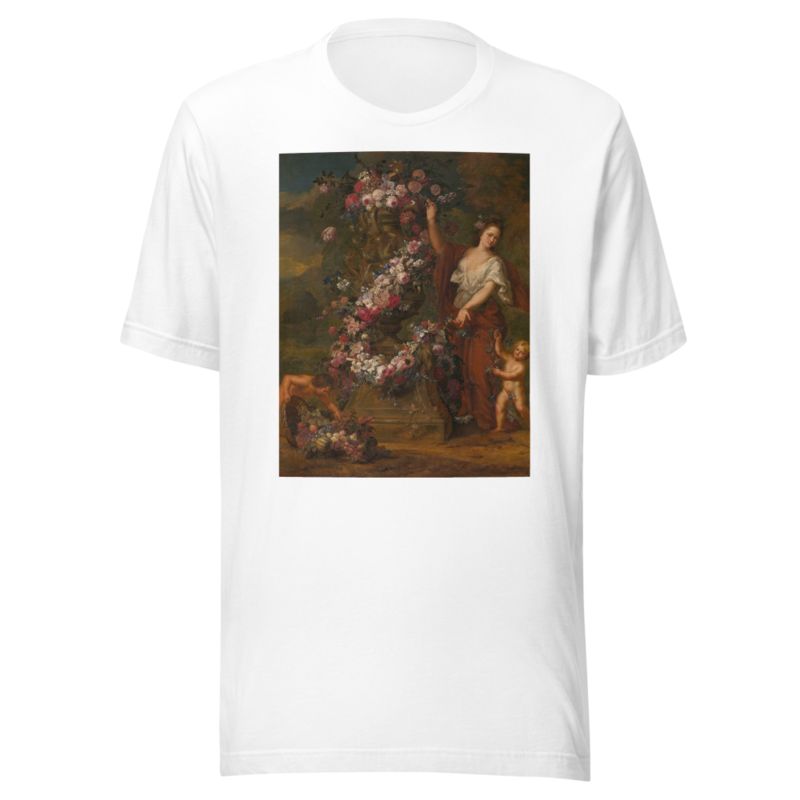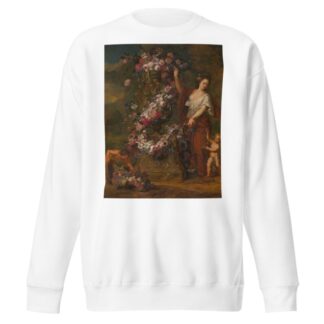Description
Allegorical Figure with Flowers by Gaspar Peeter Verbruggen the Younger printed on a T-Shirt
About the T-Shirt
Regular fit
Standard length, the fabric easily gives into movement
Casual wear
A classic, everyday option loved by our customers
Side-seamed
Constructed by sewing two parts together, creating a fitted look
The Unisex Staple T-Shirt feels soft and light with just the right amount of stretch. It’s comfortable and flattering for all. We can’t compliment this shirt enough–it’s one of our crowd favorites, and it’s sure to be your next favorite too!
- Solid colors are 100% Airlume combed and ring-spun cotton
- Ash color is 99% combed and ring-spun cotton, 1% polyester
- Heather colors are 52% combed and ring-spun cotton, 48% polyester
- Athletic and Black Heather are 90% combed and ring-spun cotton, 10% polyester
- Heather Prism colors are 99% combed and ring-spun cotton, 1% polyester
- Fabric weight: 4.2 oz./yd.² (142 g/m²)
- Pre-shrunk fabric
- 30 singles
- Side-seamed construction
- Tear-away label
- Shoulder-to-shoulder taping
- Blank product sourced from Nicaragua, Mexico, Honduras, or the US
Gaspar Peeter Verbruggen the Younger (1664-1730)
Gaspar Peeter Verbruggen or Gasparo Pedro Verbruggen was a Flemish still life painter who is principally known for his decorative still lifes with flowers and fruit. He collaborated with figure artists on compositions which combined figures with a still life element. He was active in Antwerp and The Hague.
Gaspar Peeter Verbruggen was born in Antwerp as the son of Gaspar Peeter Verbruggen the Elder and his father’s first wife Catharina van Everdonck. His father was a successful still life painter and the young Gaspar Peeter grew up in a prosperous home. His father trained him from an early age. Gaspar Peeter the Younger became in the Guild year 1677-1678 a master of the Guild of Saint Luke of Antwerp at age 13.
Verbruggen became the deacon of the Guild in the Guild year 1691/1692. In 1694 he gave one of his works called Flower garland surrounding a statue of Apollo (Royal Museum of Fine Arts Antwerp) to the Guild in thanks for accepting his pupils Balthasar Hyacinth Verbruggen and Jacob Melchior van Herck without paying a fee.
Verbruggen was successful and lived in a house on the high-end Meir. He married on 22 June 1700 with Dymphna van der Voort. His wife died not long after the union and was buried on 18 September 1702. The artist lived above his means and was forced in 1703 to sell all his paintings. The revenue from the sale was not sufficient to cover all his debts.
He decided to leave Flanders for the Dutch Republic in 1705. He established himself in The Hague where he received many commissions for the decoration of prominent residences. He joined the Guild of Saint Luke of The Hague in 1708. Despite his commercial success his expenses remained higher than his income. He returned as a poor man to Antwerp. His old art friends arranged for him to take the job of ‘knaap’ (boy) at the Antwerp Guild of Saint Luke, a position he held from 1723 to the time of his death. He was buried on 14 March 1730 in Antwerp’s Cathedral.
His pupils included his half-brother Balthasar Hyacinth Verbruggen (son of his father and his second wife Sara Catharina Raeps), Jacob Melchior van Herck (who was his brother-in-law, half-brother or step brother), Frans d’Olivero, Peter Frans Casteels and Gillis Vinck.






Reviews
There are no reviews yet.